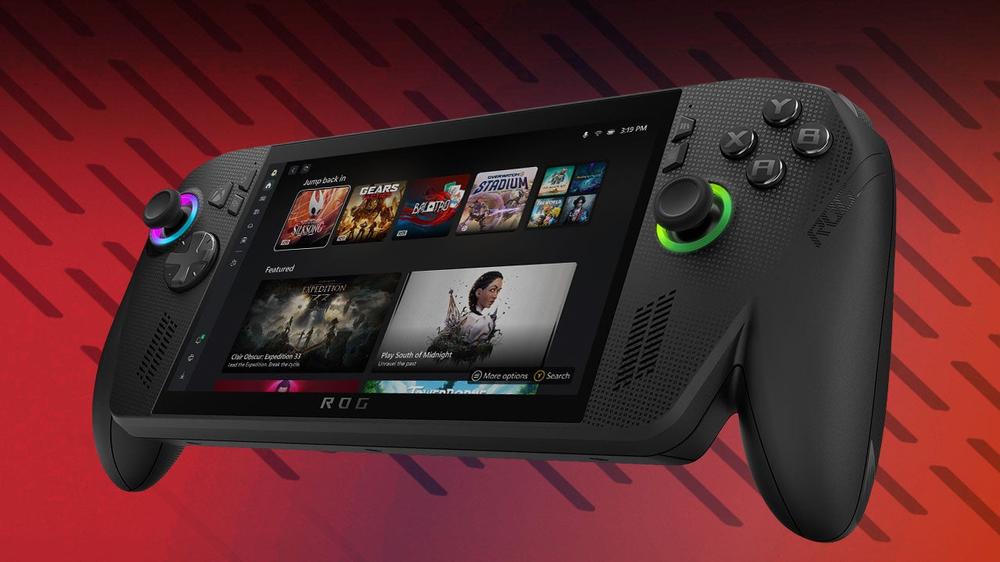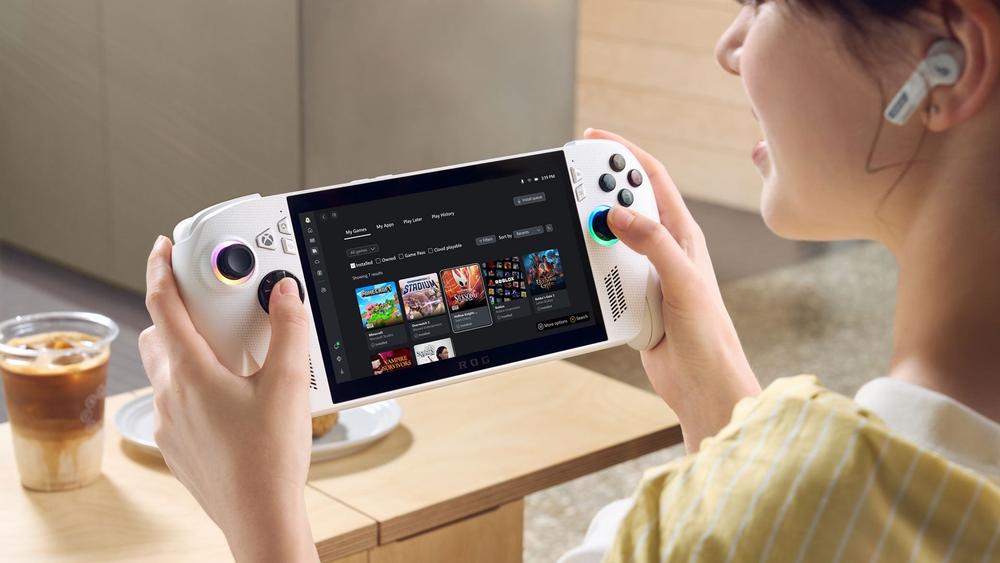The ROG Xbox Ally consoles launch on October 16th, marking the first time that Microsoft has released an official gaming handheld – albeit in heavy cooperation with Asus, makers of the original ROG Ally devices. The new ROG Xbox Ally and Ally X promise unique hardware and software improvements and could be priced aggressively, but can they compete against the Steam Deck, Switch 2 and a growing field of handheld gaming PCs?
Here's what we know so far, based on our hands-on testing at Gamescom and a host of official announcements.
This is an Xbox – but not as you might expect. So what are they?
To be clear, these aren't proper handheld Xboxes that will play any Xbox game, despite the "this is an Xbox" branding. However, they're still capable handheld gaming machines that can play a huge number of PC games natively, or stream Xbox games, either from an Xbox console or Microsoft's cloud streaming service.
Compared to the old Ally devices, the new Xbox models have been spruced up with new AMD Z2 processors and a streamlined Windows operating system. That should translate into better performance and a step forward in usability, and could make these the best Steam Deck competitors so far.
Two models with significantly different levels of performance
It's worth knowing the difference between the two Xbox Ally models arriving in October: the Xbox Ally and the fancier Xbox Ally X.
First up, the vanilla Xbox Ally offers Steam Deck level performance from its AMD Ryzen Z2 A chip, plus a higher-res screen, easier SSD upgradeability and wider game compatibility thanks to running Windows out of the box. However, the Steam Deck is available in an OLED model, is easier to drive given its lower 800p resolution, and runs the sleeker, often more performant Steam OS.
The more interesting Xbox Ally X uses AMD's brand new Ryzen AI Z2 Extreme chip, which promises the best performance we've seen in a PC gaming handheld, some exclusive Xbox features and more capable hardware. That could make it the device of choice for enthusiasts able to justify its high price – something we'll discuss later.
ChipsetAMD Ryzen AI Z2 ExtremeMemory24GB LPDDR5X-8000Storage1TB M.2 2280 SSDDisplay7" 1080p 120Hz VRR IPSI/O1x USB 4 Type-C, 1x USB 3.2 Gen 2 Type-C, 1x UHS-II MicroSD card reader, 1x 3.5mmWirelessWiFi 6E + Bluetooth 5.4Battery80WhDimensions291x122x51mmWeight715gHow fast will the new handhelds be?
So what will that performance difference look like? Looking at the hardware, the four Zen 2 cores and 8 RDNA 2 cores of the Xbox Ally ought to deliver roughly Steam Deck level performance at 15W, or a bit more at its maximum 20W TDP.
Meanwhile, the Ryzen AI Z2 Extreme's eight Zen 5 cores and 16 RDNA 3.5 graphics cores should be significantly faster than the Steam Deck. Some early Z2 Extreme test results show a ballpark 15% performance advantage over the Z1 Extreme ROG Ally at maximum power. Interestingly, these results also show higher performance differentials at lower wattages, as well as lower power draw at matched frame-rates, suggesting that overall efficiency has improved.
However, both Asus and Microsoft have said there's plenty of optimisation work to be done, so we'll need to wait for final hardware, software and drivers – and a chance to perform our own testing – before we can say anything definitive about performance.
ChipsetAMD Ryzen Z2 AMemory16GB LPDDR5X-6400Storage512GB M.2 2280 SSDDisplay7" 1080p 120Hz VRR IPSI/O2x USB 3.2 Gen 2 Type-C, 1x UHS-II MicroSD card reader, 1x 3.5mmWirelessWiFi 6E + Bluetooth 5.4Battery60WhDimensions291x122x51mmWeight670gAI features coming in 2026 – for the Xbox Ally X only
The Z2 Extreme also comes with dedicated AI hardware, with 50 TOPs of AI throughput, so what is it capable of? Out of the box, not much, but a few tantalising AI features are scheduled for 2026.
The most interesting is Auto SR, an FSR1-like post-process upscaling that has a fixed latency cost. This was an impressive option when it debuted on Snapdragon X Windows laptops, and this will be the first time it's more widely available.
Microsoft's marketing also notes a highlight reel feature, which promises to automatically generate clips of boss takedowns or multi-kills for social media.
A thicker, comfier design with upgraded controls and impressive specs
Let's talk about design. First, the vanilla Xbox Ally has a white shell, while the Xbox Ally X comes in black. Despite their varying capabilities, both Xbox Ally models are the same size, at 291 x 122 x 51mm, with a thicker design than the OG ROG Ally. That allows for proper Xbox-style controls and a comfier grip. Both models come with the same seven-inch 1080p 120Hz VRR LCD display as the original ROG Ally too.
The Xbox Ally X is 45g heavier than the standard Xbox Ally. A lot of that is due to a battery upgrade, from 60 watt hours to 80 watt hours, and the inclusion of dual-motor Impulse triggers. The X also upgrades one of the two USB-C 3.2 Gen 2 ports on the vanilla model to USB 4, unlocking full speed access to DisplayPort 2.1 and Thunderbolt 4 devices – including external graphics cards.
Inside, the vanilla model gets 512GB of storage and 16GB of 6400MT/s RAM, while the X gets 1TB of storage and 24GB of 8000MT/s RAM. Both models use large M.2 2280 SSDs for easy upgradeability, rather than the smaller 2230 standard used on the original ROG Ally and Steam Deck. Finally, both devices come with a 65W charger and a stand in the box.
A redesigned interface, a wider launcher and more software updates
As well as some promising hardware, the Xbox Ally uses a new "Xbox Full Screen Experience" that promises a more gamepad-friendly interface and better performance than prior Windows gaming handhelds. For example, you can log in using the gamepad, rather than needing to enter your PIN via touch or use a fingerprint reader, which loads you into a full-screen Xbox app. Gamepad controls should work everywhere here, and you can hold down the dedicated Xbox button to quickly swap between games and apps or close them. There are also phone-style touch gestures to access the Game Bar or change apps.
The core Xbox app has seen some key improvements, including new library features that automatically bring in games from other launchers like Steam or GOG – though you'll need to actually install these games in the desktop Windows mode. However, once installed, you can see all of your games in the same place.
Microsoft is also debuting an evolution on the Steam Deck Verified idea, with separate ratings for handheld optimisation and performance. The Handheld Optimised badge indicates a game that has a suitable interface and gamepad controls, while the Windows Performance Fit shows whether it'll run in excess of 30 or 60fps on your device.
There's even a Gaming Copilot that you should be able to ask for tips to progress in-game, or check your achievement progress, with the AI receiving a screenshot of your current game to help you. If you've used an ROG Ally handheld before, you'll be familiar with the Asus Armoury Crate app. This software will still be used for changing performance profiles, showing overlays and so on.
And while Microsoft imagines that you'll spend most of your time in the new handheld-optimised mode, you can still access a full version of Windows 11, which spools up services like the desktop window manager that don't start in the default gaming mode. Afterwards, you can reboot to ensure you're getting full performance, or go straight back into the gaming UI if you're expecting to dip back and forth a few times.
Hands-on impressions from Gamescom
So how does the Xbox Ally actually play? Based on our hands-on time at Gamescom, both machines feel capable. They sport the same bright and responsive LCD display as the original Xbox Ally, but with improved ergonomics that are more in line with the Steam Deck than the Switch 2. The new user experience felt a little buggy, requiring a reboot on our first tester unit, but the improved launcher, touch gestures and fast game switching felt good and saved time.
With their Windows performance optimisations, plus extra power under the hood on Xbox Ally X, these could be some of the most capable gaming handhelds on the market… but we'll have to wait for final hardware and software before rendering a verdict.
Official Xbox Ally pricing has finally been announced
Microsoft has confirmed that the lower-end Xbox Ally will retail for $599, while the full-fat Xbox Ally X will cost $999. In the UK, the Ally X will cost £799, while the Ally will cost £499. The EU reference prices are similar, at €899 and €599.
These prices suggest the Xbox Ally could be a shade cheaper than other Z2 Extreme-powered handhelds, like the MSI Claw A8 at £850 (about $1160) or the Lenovo Legion Go 2 at $1350, but still painful compared to, say, $650 for the most expensive Steam Deck.
As gaming gets even more expensive across the board, this handheld Xbox is a pricey privilege, no doubt. For its part, Microsoft is doubtlessly incentivized to keep prices as low as possible, in order to reap Game Pass subscriptions and game sales from a wider install base, but Asus is also looking to justify its long investment into PC handhelds – and create meaningful separation from its existing ROG Ally models. Ultimately, the value question comes down to the quality of the software and the strength of the silicon, both of which are still unknown quantities.
Can Microsoft's secret sauce elevate the Xbox Ally consoles above other PC handhelds?
It feels like the Xbox Ally handhelds were originally pitched as offering both unique hardware and software, but consumers will be able to pick up other Z2 Extreme handhelds from MSI and Lenovo around the same time – though the Xbox-style controls remain unique. The unique software promise is time-limited too, as Microsoft has said that its handheld optimisations will arrive on other PC handhelds, and the revised launcher is already available on existing devices.
Regardless, the Xbox Ally and Ally X could be the best value PC gaming handhelds at their respective price points, and it'll be fascinating to see whether Microsoft's console expertise pushes them to the top of what is an increasingly competitive field.

 Viral “table surfing” TikTok challenge leaves teen dead, another facing life-altering injuries
Viral “table surfing” TikTok challenge leaves teen dead, another facing life-altering injuries